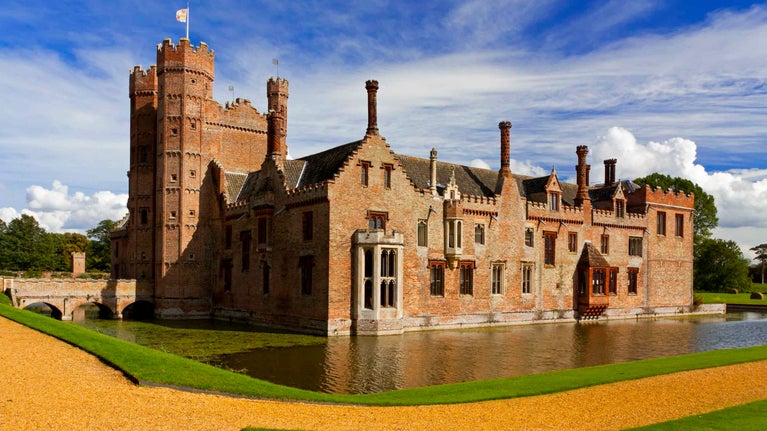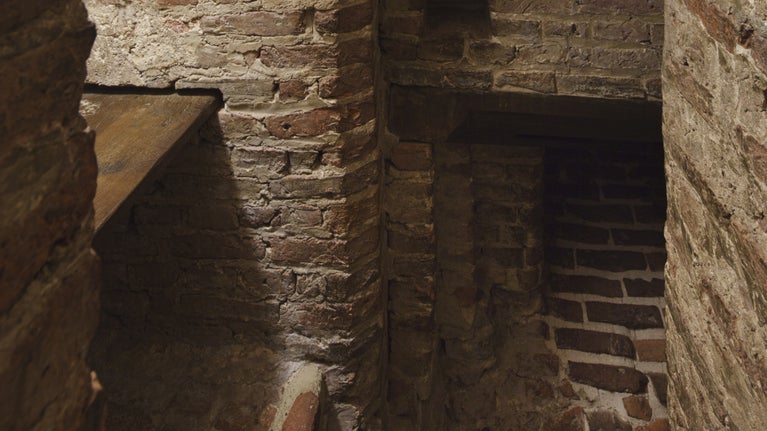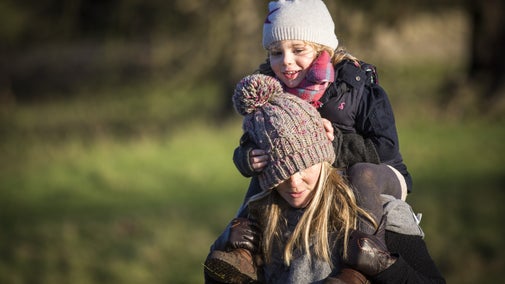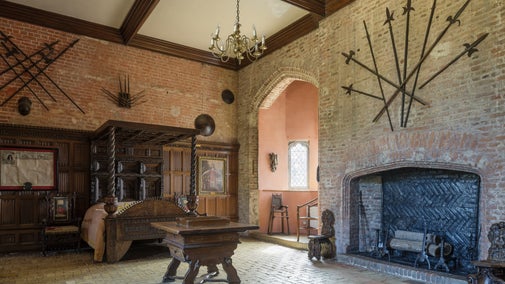
Oxburgh Estate's collections
Explore the objects and works of art we care for at Oxburgh Estate on the National Trust Collections website.

Oxburgh Estate has been the home of the Bedingfeld family for over 500 years. The story of the estate maps the ebb and flow of British history. As Catholics, the family endured centuries of religious persecution following the English Reformation and the political upheaval of the English Civil Wars. In the 19th century, the Catholic Emancipation Act of 1829 and several strategic marriages led to a revival of the estate.
The name ‘Oxborough’ is from Old English and means a fortified place to keep oxen. Archaeological investigations reveal the earliest human activity on site dates from the Neolithic period.
The village of Oxborough is recorded in Domesday Book in 1086 with a population of 35 households. Subsequent owners of the Oxburgh Estate include members of the de Weyland and Tuddenham families. Sir Thomas Tuddenham (d.1462) was executed for treason and his estate passed via the female line to Sir Edmund Bedingfeld (1443–96).
The red brick Hall with its imposing Gatehouse and surrounding moat is the work of Sir Edmund Bedingfeld. A rising star in the court of Edward IV, Sir Edmund received royal permission to fortify his new home in 1482.
The choice of brick, a building material most often reserved for royal buildings, reflected Sir Edmund’s political and social aspirations. The family’s ambitions survived the transition of power to Henry VII at the conclusion of the War of the Roses. In 1487 Edmund received a battlefield knighthood. His sons hosted a prestigious royal visit in 1498.
Over the next 100 years, the power and influence of the Bedingfeld family became tied to the progress of the English Reformation and the fate of English Catholicism.
The family initially thrived under Henry VIII. Following his divorce from Katherine of Aragon, Henry appointed Sir Edmund Bedingfeld (1480–1553) as her steward. Sir Edmund and his wife, Grace (c.1487–c.1553), organised the former queen’s funeral at Peterborough Cathedral.
But as Henry VIII’s break with Rome deepened, the Bedingfelds found their adherence to Catholicism at odds with their political ambitions.
The brief reign of Catholic Queen Mary brought renewed royal patronage. Sir Henry Bedingfeld (1511–83) served as gaoler and protector of Protestant Princess Elizabeth. His loyal service resulted in the post of Lieutenant of the Tower of London and a seat on the Privy Council. The wealth and influence of the Bedingfeld family at court had reached its zenith.
When Elizabeth succeeded in 1559, Sir Henry’s fortunes changed dramatically. He refused to sign the Act of Uniformity which outlawed Catholic Mass. The Bedingfeld family’s staunch adherence to Catholicism under Elizabeth resulted in exclusion from public office, heavy fines and the threat of imprisonment.
At the height of Elizabeth’s reign, English Catholics faced great uncertainty and danger. Many Catholics retreated from public life, practising their faith in secret. At Oxburgh, the Bedingfelds constructed a priest hole to conceal any visiting priests and other evidence of Catholic worship.

By the 17th century, the Hall and Estate were in poor condition. A relaxation of anti-Catholic laws under Charles I was short-lived.
The Civil Wars proved near catastrophic for the Bedingfeld family and Oxburgh. Sir Henry Bedingfeld (1582–1657) and his sons fought for the King at Marston Moor in 1644. Following the royalist defeat, Sir Henry was imprisoned in the Tower of London.
Oxburgh Hall was ransacked by parliamentary troops and most of the east range burnt down. The Estate was confiscated by Parliament and forcibly sold in 1652.
At the Restoration, the family received a baronetcy in recognition of their loyal service to the Stuart crown but no financial compensation for their losses. Sir Henry Bedingfeld, 1st Baronet (1613–84) inherited Oxburgh in 1665, but considered the house uninhabitable. The family’s continued adherence to Catholicism meant no return to public office.
Over the next 100 years the Bedingfelds spent considerable time in Europe and developed extensive ties to the continental Catholic community. They educated their children in the English colleges overseas and an extraordinary number of family members entered religious life. Many of their portraits hang on the walls at Oxburgh.
Following the crowning of William and Mary in 1689, the Bedingfeld family continued to support James II and his descendants in exile. Sir Henry Arundell Bedingfeld, 3rd Baronet (1689–1760) is now believed to have been a secret Jacobite and may have supplied arms to Bonnie Prince Charlie in 1745. A Jacobite drinking glass purchased by Sir Henry is on display in the Drawing Room.
The Bedingfeld family remained well-connected to the English Catholic community at home and overseas. Marriages to other Catholic families brought not just social and religious connections, but much-needed financial support.
In 1761, Sir Richard Bedingfeld, 4th Baronet (1726–95) married Mary Browne (d.1767) of Cowdray Park, a relative of the staunchly Catholic Montagu family. As part of her marriage settlement, Mary brought the embroideries of Mary, Queen of Scots to Oxburgh (now known as the Oxburgh Hangings). Richard and Mary’s marriage ended tragically when she died shortly after giving birth to the couple’s only son.
The 4th Baronet retired to Oxburgh and began to restore the Hall and Estate. In 1775 he demolished the Great Hall and built the two Neo-classical pavilions that dominate the southern range of the Hall today.
From 1778 to 1791, the passage of the Catholic Relief Acts eased many of the restrictions placed on Catholic families. For the first time in over 200 years, Catholics could purchase land, build chapels and hold public office.

In 1826 Sir Henry Bedingfeld, 6th Baronet (1800–62) married Margaret Paston (d.1887). As the last Paston heir, Margaret brought with her a substantial inheritance. The Catholic Emancipation Act (or Third Catholic Relief Act) of 1829 overturned the remaining restrictions on Catholic families enabling a return to public life and ushering in an era of celebration and revival.
The newly named Paston-Bedingfelds commissioned the architect John C. Buckler to restore Oxburgh in the Gothic Revival style and celebrate the estate’s medieval past.
Buckler’s design added decorative chimneys and windows to the exterior of the Hall and transformed the interiors. The Library, with its flock-on-gilt wallpaper and heraldic decorations, presents the most complete neo-Gothic interior at Oxburgh.
Margaret planned an extensive renovation of the gardens. In 1840 she had the parterre laid out as a ‘pretty embroidered garden’, possibly inspired by her visits to historic gardens in France and Belgium. The kitchen gardens were tidied and resown, and Buckler created new garden walls with decorative turrets echoing the architecture of the Hall.
The family Chapel was completed in 1836. Possibly designed by Buckler, the Chapel features stained-glass windows by Thomas Willement. The Paston-Bedingfelds acquired the 16th-century altarpiece during their travels in Belgium.
For the first time in three centuries, the Bedingfeld family had access to lucrative public offices throughout the British Empire. The 6th Baronet’s younger brother, Felix Bedingfeld (1808–84), served as a British government colonial official in the Caribbean.
Trained as a lawyer, Felix was first posted to Montserrat in 1833 as legal advisor overseeing the implementation of the Abolition of Slavery Act. In 1836 Felix received £1,024 5s. 2d. in compensation for 61 enslaved people working on his Montserrat estate. Felix later served as a Crown Commissioner in the Turks Islands (1842–9), Master of the Supreme Court in Trinidad (1849–54), and Colonial Secretary in Mauritius (1860–8).

Like many other large estates in the early 20th century, Oxburgh experienced a slow decline. After the Second World War, estate tenants and labourers sought work elsewhere. With overdue rents and the mounting costs of modernisation, the financial burden of maintaining Oxburgh became too much.
In 1951, Sir Edmund Paston-Bedingfeld, 9th Baronet (1915–2011), sold the 3,653-acre estate to the Eagle Star Insurance Company. The estate was divided into individual lots and re-sold at auction.
Sybil Paston-Bedingfeld (1883–1985), the 9th Baronet’s mother, successfully re-acquired ‘Lot 1’ – the Hall and its gardens – and gifted it to the National Trust in 1952.
The National Trust has cared for Oxburgh for nearly 75 years, during which time it has invested in the conservation and expansion of the estate. Oxburgh Estate now includes 200 acres for visitors to explore including the hall, formal gardens and parts of the historic parkland.
From 2016 to 2022 the National Trust embarked on a major project to replace the roof of the Hall. During the project, archaeologists recovered hundreds of objects from under the floorboards at Oxburgh providing new insights into the everyday lives of Oxburgh’s inhabitants from the 16th century to the 20th century. Work is currently underway to restore areas of the historic parkland acquired in 2017.
Catholic Record Society, Miscellanea VI: Bedingfeld Papers, Ballantyne Hanson & Co., 1909
Michael Bath, Emblems for a Queen: The Needlework of Mary Queen of Scots, Archetype Publications, 2008
Felix Bedingfeld (plantation owner and awardee), Legacies of British Slave-ownership Database, UCL - http://wwwdepts-live.ucl.ac.uk/lbs/person/view/25004
Monserrat 141 – Amershams (claim), Legacies of British Slave-ownership Database, UCL - http://wwwdepts-live.ucl.ac.uk/lbs/claims/view/24921
Oxburgh’s Roof Project - Oxburgh’s roof project │ Norfolk | National Trust

Explore the objects and works of art we care for at Oxburgh Estate on the National Trust Collections website.
Whether you're building a den, becoming a nature explorer or searching for secret doorways, Oxburgh has plenty to keep the whole family entertained.

Oxburgh has been home to the Bedingfelds for more than 500 years, and they still live within private apartments at Oxburgh today. Discover what you might see on your visit.

Find out more about the £6 million project at Oxburgh Estate, which included repairs to the roof, windows, chimneys and medieval gatehouse façade, securing Oxburgh’s future and the collection within.
Learn about people from the past, discover remarkable works of art and brush up on your knowledge of architecture and gardens.
